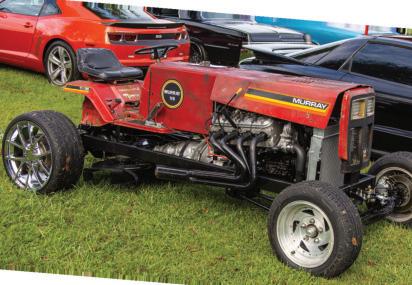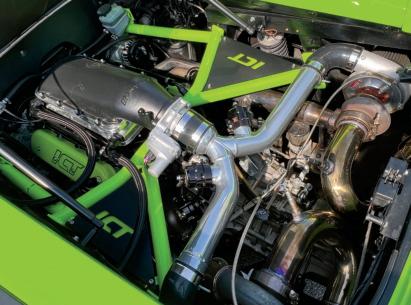
9 minute read
NO-PREP HERO
Austin Shepherd’s budget-built RX-7 defies gravity, wins races, and pleases crowds.
The first time you see Austin Shepherd’s 1985 Mazda RX-7 fly down the track, you’ll ask yourself, “Did I just witness that?” The second thing you’ll think is, “I gotta take a closer look.” Lil Heavy, as it’s known in the rural hamlets and backwoods tracks of northern Indiana, is not possessed of huge amounts of power. On the contrary, it’s relatively modest and somewhere between 1,000 and 1,200 hp by Shepherd’s own admission. The thing it’s good at is getting down a rotten road fast and doing it straight as a string.
Advertisement
What you see is definitely not what you get as the bruised and battered beer-can of a car pulls to the line and its 5.3-liter LS begins to build boost. But it’s 100 percent subterfuge. Lil Heavy leaves the line with all the drama of a loaded UPS truck, its twin Forced Performance 7275 turbos barely making any boost, but within a car’s length the Mazda’s front end is fully extended and the front tires begin to float inches above the pavement. It’s here where many high-powered track cars make their first mistake, either overpowering the track with tire spin or continuing an upward trajectory into certain disaster. If you are in the opposite lane from Shepherd, this is also the moment when it dawns on you the error of your ways. This is not a car to be trifled with.
NO-PREP HERO
The amazement of seeing such a performance is not lost on its owner, who experienced the same epiphany. At the time the RX-7 came into Austin’s life, he was running a turbo-LS 1978 Chevy C10 in a Small-Tire Street-Tire class, but it was nothing special. Then he saw the Mazda at a Small Tire grudge race at Bunker Hill, Indiana, in 2019. At the time, the RX-7 had a single-turbo LS; it had won the Small Tire class and that stuck in his head. “That kind of drew me into the car—and a few years later it popped up on Facebook Marketplace. I couldn’t pass it up after seeing what it was capable of.” Let that story be a lesson, don’t be ashamed to improve on the hard work of a previous owner.

Armed with the insider intel that the Mazda’s bite was a lot more painful than its visual bark, Shepherd bought the Mazda in 2021 as a roller for around $5K. Much of the alchemy of Lil Heavy was already baked-in, including a back-half chassis consisting of the rollcage tying the flexible Mazda chassis together and a custom four-link rear suspension attached to a 4.10-geared, spooled Ford 8.8-inch rearend of unknown origin. The Mazda’s rollcage had an important modification that would give it an advantage on dicey track surfaces: a system of attachment points for spare gym weights. In essence, free weights that had never been lifted in the gym would allow Shepherd to “never lift” off the throttle in a race.
The added rear weight has been a godsend in leapfrogging grudge-race competitors who often have far more money and technology. Shepherd says, “A lot of the cars at places we race have traction control, and my car doesn’t have any of that, so we try to get enough weight in it that you know it’s not going to spin the tire, but not so much that it’s going to stand up and do a wheelie. We kind of ride the fine line of trying to make it do a wheelie and just barely hover off the ground.” According to Austin, Lil Heavy tips the scale anywhere between 2,950 and 3,400 pounds, depending on the type of race he’s running.
To that point, Austin mainly runs two types of races: street car events and a newer kind of racing called back track or back-of-track racing. “For the Street Car class I had to have working windows, headlights, taillights, turn signals, all that. Once I got the built motor and got to where we could get some data, we gutted the car completely. So those red doors and the no-front-end are what I run for every back track race I go to, to get the weight off it. By taking the front end off and gutting it with the same weight bias with the weights in the back, I can cut out about 400 pounds.”
Separate from the crowd-pleasing nature of Austin’s Mazda is the

NO-PREP HERO
fact that it’s an answer to the age-old riddle of how to have a competitive car without going broke—the mechanical equivalent of having your cake and eating it. Part of that is picking your battles carefully. Says Austin, “Anything that’s at a good track, it’s hard to be competitive. That’s why we do the back track racing, because the horsepower doesn’t always win. A 1,200hp car can go 5.80s just as well as a 2,000hp car. If you’re going 5.80s at a back track race, you’re going to be one of the fastest cars there because that’s all the road can hold.”


Back track racing? What’s that? When the street racing thing surged years ago with the popularity of shows like Street Outlaws, drag racing was at an impasse; some racers stayed in the legal, sanctioned drag racing camp, while others—sometimes forced into it by metropolitan-area track closures (Chicagoland, Palm Beach, Atlanta, Fontana, Memphis, Houston, Englishtown, and so on)—became outlaw street racers. Street racing is less about making big power and more about the science of traction on bad surfaces, and that learning curve resulted in a third racing alternative: back track racing. In this form of competition, street racers adept at finding traction on ordinary tarmac turned to the little-used, shut-down areas of smaller, rural tracks on which to run their no-prep races, done street racestyle with a flashlight.
Back track racing has its pros and cons. In the positive column, grudge racers can compete to their hearts’ content away from the prying eyes (and handcuffs!) of the law. They also gain the benefit of safety personnel being on hand in the event of an accident. Without a giant investment in lane prep on the shoulders of the tracks or promoters, the cost to racers can be kept low, and the down-home, backyard-tire-fire atmosphere can’t be beat. Traditional drag racers argue that low-traction conditions are a safety red flag and running the wrong direction down a track has the potential to go wrong in a bad way. Considering these concerns, many promoters are steering clear of tracks with challenging back-of-track layouts, choosing venues that lend themselves to safer back track racing. The takeaway is this: Grudge racers who prefer the technical challenge of a typical street surface and the level playing field it provides now have a fresh playground to frolic in.
Austin explains the allure of back track racing thusly, “You can almost be shut down before you ever even make it to the end of the track, and then you’ve still got an eighth-mile or a quarter-mile to stop if you wanted to. It’s perfect for low-budget racing. To be able to be a budget car and still compete is the way to go. We use a traction compound, which you can basically use for your burnout, and that’s
NO-PREP HERO
it. After your burnout it’s whatever the track gives. You can’t go out there and prep in front of you or anything.” To take full advantage of the back track racing surface, however, you need to be at the top of your game with power application and suspension tuning.

For the former, Austin has turned to a tried-and-true twin-turbo aluminum 5.3 LS with 10.5:1 compression from a 2007 Tahoe recently refreshed by Northwest Auto & Machine of Fort Wayne, Indiana. The bullet uses box-stock Trick Flow GenX 220cc heads (O-ringed with TKM mini-hoops) with a BTR all-forged rotating assembly and twin-turbo Stage 3 cam. It’s fed by a Holley Dominator ECU that controls a set of 220 lb/hr fuel injectors in a Holley Lo-Ram intake with a 102mm Sniper throttle body. These injectors feed the engine a diet of good ol’ Hoosier-brewed E85, which is a low-cost substitute for expensive race fuel. The twin Forced Performance 7275 turbos mentioned earlier are chilled by an air-to-water intercooler of unknown origin that Shepherd picked up in trade for wiring a buddy’s car.

The powertrain combo in Lil Heavy is simple, easy to maintain, and hits way over its weight for the investment it represents. Making 1,200 hp is not a difficult task, but keeping the car straight and pulling like a freight train is. Taming the beast is the job of the Holley Dominator’s boost control. Austin says he likes to leave on just 3 psi of boost, then gradually ramp up the boost over the next 3.5 seconds to around 36-37 psi (by the 330-foot mark). One tip Austin picked up from the previous owner was to launch the Beavans Racing-built three-speed Turbo 400 automatic (featuring a Hughes bolt-together converter) in Second gear to kill the tire spin off the line, a practice that has served him well in a camp that overwhelmingly prefers Powerglide two speeds.



“You can’t spin in First and figure it out from there,” explains Austin. Driving the car is a careful balancing act he’s refined over time, whereby there’s only a few precious pounds of weight on the front tires to affect steering input. Lil Heavy seems to bounce lightly off the track its entire run, virtually all its weight on the small 28x10.5 back tires, gasser style. “It’s about trying to have enough weight and the shocks set right beforehand, so you can at least make a pass and kind of work backward on it. Once we make one run we’re usually sitting pretty good because we know about where we need to be on that surface.”
And here is where we get to the real meat of the issue: shock rebound tuning. Austin uses AFCO Fox-body Big Gun long-travel shocks up front, and they are one of the biggest factors in Lil Heavy’s tuning regimen. Austin says, “Some of the surfaces are good enough that you can tighten them up to get full extension past the 60 foot, or if it’s a real bad track, I let it come up right away just to get all the weight on the back. It ended up working out that, when I stuck them on the car, at full travel, it’s probably a quarter-inch away from maxing out at the ball joint. It works out about perfect.”


When Austin puts Lil Heavy’s tune together for an important run, it’s a package that’s hard to beat. It starts with the sky-high, nose-up attitude that puts most of the weight on the rear, then as it leaves, slowly puts the remaining weight on the rear tires, but not so quickly that the weight over-centers the rear tires for a monstrous wheelie. From there the boost comes on, maintaining nearly all the weight on the rear while allowing the front tires (on stock RX-7 wheels!) to occasionally kiss the pavement for any needed steering input. It’s a brute-force ballet worthy of the Bolshoi, and a damn sight more interesting.
Getting to this point, however, was by virtue of a tightknit group of grudge racers and builders that are as close as family. At the top of the list is Nick Taylor, aka Nickky Bobby. Taylor’s shop in Fort Wayne, Indiana, is where Austin has worked for a couple of years. He says Taylor taught him most of what he’s learned about building and racing a competitive grudge car. A little closer to Shepherd’s hometown of Wabash, Indiana, is Lil Heavy’s crew chief and Austin’s right-hand man, Chase Ladig. Whether it’s going out to make test hits or to advise on lane conditions, Ladig has proven indispensable to Austin. “It doesn’t matter where we go, he’s always with me,” says Shepherd. He also credits Justin Davis with helping maintain the car between contests. Last, but certainly not least, is Shepherd’s fiancée, Amber Ballard, who helps with topping off the intercooler ice, tire pressure, and moral support.
You’re probably dying to know if this car’s a moneymaker. “Yes,” says Austin. “I’ve done really well this year with the help of the people I’ve been with. I’ve won probably three or four this year. It’s nearly paid the car off for what I’ve got in it,” Austin says, citing his biggest win in Michigan for $12,000.
“Overall, it’s paid off my racing for the year. I’ll get to race the rest of the year without any money out-of-pocket.” Since showing up for Roadkill Nights this past August, there may be a bigger target on his back. Austin put on a show that was noticed by us—and by would-be competitors. Think you’ve got what it takes to put Lil Heavy on the trailer? Let the callouts begin!









